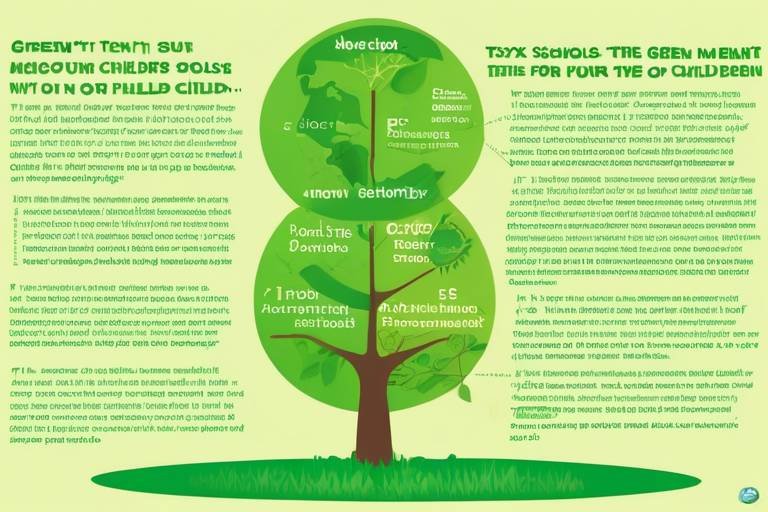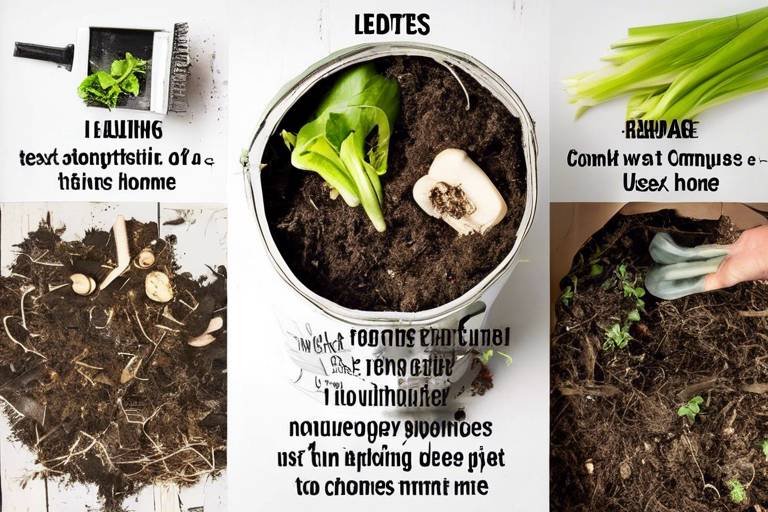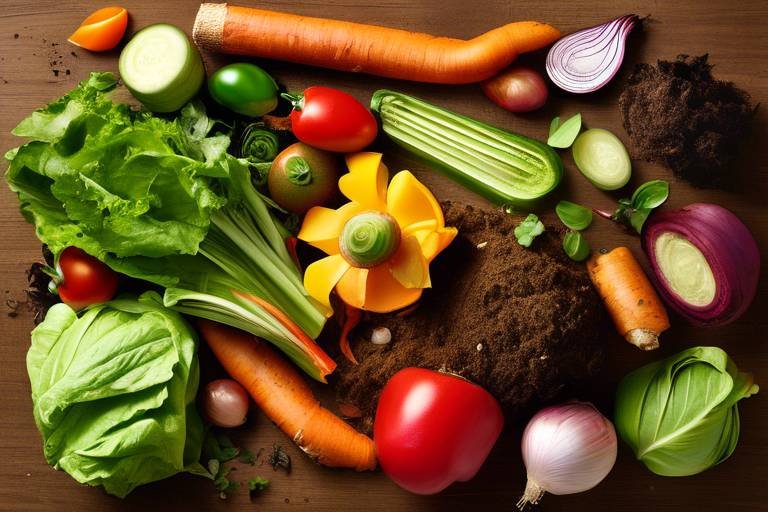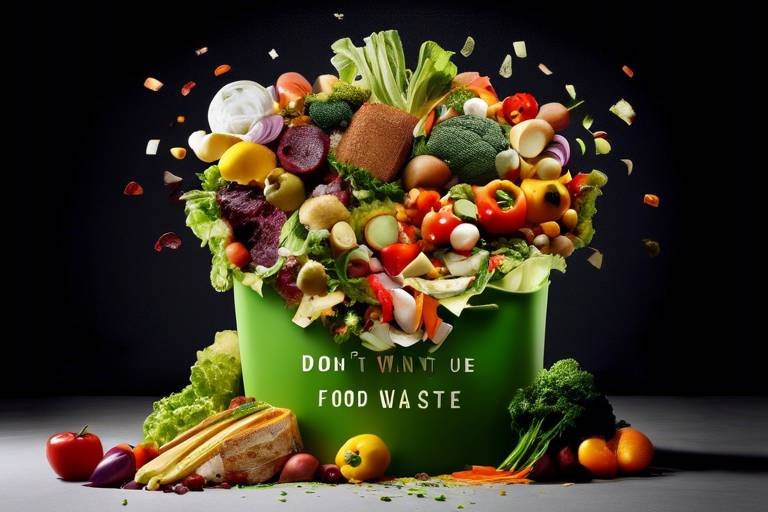The Importance of Sustainable Practices in Agriculture
In today's fast-paced world, the need for sustainable practices in agriculture has never been more critical. With the global population expected to reach nearly 10 billion by 2050, our food systems face immense pressure. Sustainable agriculture isn't just a trend; it’s a necessity. By focusing on methods that are environmentally friendly, economically viable, and socially responsible, we can ensure that we meet our current food needs without jeopardizing the future of our planet.
Imagine a farming system where the soil is rich and vibrant, crops are grown without harmful chemicals, and water is conserved efficiently. This is the essence of sustainable practices in agriculture. It’s about creating a harmonious relationship between farming and the environment. By adopting these practices, farmers can enhance biodiversity, improve soil health, and contribute to a more stable climate. But what exactly does sustainable agriculture entail? It’s a blend of techniques and philosophies designed to create a balanced ecosystem.
One of the core principles of sustainable agriculture is the idea of ecological balance. This means working with nature rather than against it. For instance, crop rotation and intercropping can help maintain soil fertility and prevent pests naturally, reducing the need for synthetic fertilizers and pesticides. Additionally, sustainable practices promote resource conservation, ensuring that we use our natural resources wisely. By minimizing waste and maximizing efficiency, farmers can produce food in a way that respects the environment.
Moreover, sustainable agriculture also emphasizes social equity. It’s not just about the environment; it’s about people too. Ensuring fair wages for farmworkers and supporting local communities can lead to a more just food system. When farmers are treated fairly, they are more likely to invest in sustainable practices that benefit everyone. This holistic approach to farming creates a cycle of positivity that can uplift entire communities.
As we delve deeper into the benefits of sustainable practices, it becomes clear that these methods are not just beneficial for the environment—they also enhance agricultural productivity and resilience. For instance, healthy soil is the foundation of sustainable farming. Techniques like cover cropping and no-till farming improve soil structure and fertility, leading to better yields and less erosion. When farmers invest in their soil, they invest in their future.
In conclusion, the importance of sustainable practices in agriculture cannot be overstated. They offer a pathway to a more sustainable food system that benefits the environment, economy, and society as a whole. As we face the challenges of the 21st century, embracing these practices will be essential for ensuring food security for generations to come. So, let’s commit to a future where agriculture thrives in harmony with the planet.
- What is sustainable agriculture? Sustainable agriculture refers to farming practices that meet current food needs without compromising the ability of future generations to meet their own needs.
- Why is sustainable agriculture important? It helps protect the environment, supports local economies, and ensures food security for future generations.
- What are some examples of sustainable practices? Examples include crop rotation, organic farming, agroecology, and water conservation techniques.
- How does sustainable agriculture benefit farmers? It can lead to improved soil health, reduced input costs, and increased resilience against climate change.

Understanding Sustainable Agriculture
Sustainable agriculture is not just a trend; it’s a necessary approach to farming that aims to meet the food demands of today without jeopardizing the needs of future generations. Imagine a world where our farming practices don’t just feed us but also nourish the planet. This concept revolves around three critical principles: ecological balance, resource conservation, and social equity. In essence, sustainable agriculture is about cultivating food in a way that respects the earth and its inhabitants.
At its core, sustainable agriculture seeks to create a harmonious relationship between human activity and the natural environment. It emphasizes the importance of maintaining biodiversity, which is crucial for a resilient ecosystem. By fostering a variety of plant and animal life, farmers can create a more robust agricultural system that can withstand the pressures of pests, diseases, and climate change.
Moreover, sustainable practices advocate for the responsible use of resources. This means not over-extracting from the land or exploiting water supplies. For instance, farmers are encouraged to implement methods that conserve water, such as drip irrigation, which minimizes waste and ensures that crops receive the moisture they need without depleting vital water sources. It's like giving your plants a drink without drowning them!
Social equity plays a pivotal role in sustainable agriculture as well. This principle focuses on ensuring that farming practices are fair and just for all involved, from the farmers to the consumers. It promotes fair wages for agricultural workers and supports local food systems that benefit the community. When farmers thrive, everyone wins!
In summary, understanding sustainable agriculture is about recognizing its multifaceted nature. It’s not merely a set of practices but a comprehensive approach that intertwines environmental health, economic viability, and social justice. By adopting sustainable methods, we can create a food system that is resilient, equitable, and capable of supporting future generations.
- What is sustainable agriculture? Sustainable agriculture refers to farming practices that meet current food needs while ensuring that future generations can also meet their needs.
- Why is sustainable agriculture important? It is crucial for maintaining ecological balance, conserving resources, and promoting social equity within farming communities.
- How does sustainable agriculture benefit the environment? It improves soil health, enhances biodiversity, and reduces environmental impacts such as pollution and water depletion.
- What are some common sustainable farming practices? Techniques like crop rotation, organic farming, agroecology, and water conservation methods are widely used in sustainable agriculture.

Benefits of Sustainable Practices
Implementing sustainable practices in agriculture isn’t just a trend; it’s a necessity for our planet's health, our economy, and our future food security. When farmers adopt these practices, they’re not only nurturing their crops but also fostering a more resilient ecosystem. Imagine a world where farming doesn’t deplete our natural resources but instead rejuvenates them! This is the essence of sustainable agriculture. By focusing on methods that enhance the environment, we can significantly improve soil health, boost biodiversity, and reduce our overall environmental impact.
One of the most significant benefits of sustainable practices is the enhancement of soil health. Healthy soil is like a vibrant community; it thrives with life and supports a variety of organisms. Techniques such as crop rotation and cover cropping play a crucial role in maintaining soil fertility and structure. For instance, rotating crops helps prevent nutrient depletion and disrupts pest cycles. Cover crops, on the other hand, protect the soil from erosion and enhance its organic matter. The result? A robust soil ecosystem that leads to better yields and less reliance on synthetic fertilizers.
Moreover, sustainable practices promote biodiversity. When farmers diversify their crops, they create a more resilient agricultural system. This diversity can help mitigate risks associated with climate change, pests, and diseases. By cultivating a variety of plants, farmers can ensure that even if one crop fails, others may thrive. This is akin to having a safety net; it provides security against unforeseen challenges. Additionally, increased biodiversity contributes to healthier ecosystems, which in turn supports pollinators and other beneficial organisms essential for food production.
Another compelling benefit of sustainable practices is the reduction of environmental impact. Traditional farming methods often lead to soil degradation, water pollution, and loss of wildlife habitats. In contrast, sustainable practices focus on minimizing these negative effects. For example, integrated pest management (IPM) reduces the need for chemical pesticides by using natural predators and biopesticides. This not only protects the environment but also enhances food safety. By reducing chemical inputs, farmers can produce healthier food while preserving the delicate balance of our ecosystems.
In addition to environmental benefits, sustainable practices can also lead to economic advantages. Farmers who adopt these methods often find that they can reduce their costs over time. By using organic fertilizers and natural pest control methods, they can lower their dependency on expensive synthetic inputs. Furthermore, as consumers become more environmentally conscious, there’s a growing market for sustainably produced goods. Farmers can capitalize on this trend by offering organic and sustainably sourced products, often fetching higher prices in the market.
To summarize, the benefits of sustainable practices in agriculture are vast and interconnected. They lead to improved soil health, enhanced biodiversity, reduced environmental impact, and economic advantages for farmers. By embracing these practices, we’re not just ensuring a better future for ourselves but also for generations to come. The journey towards sustainable agriculture is not just a choice; it’s a responsibility we all share.
- What is sustainable agriculture? Sustainable agriculture focuses on farming practices that meet current food needs without compromising future generations' ability to produce food.
- How does sustainable agriculture benefit the environment? It promotes soil health, biodiversity, and reduces the reliance on harmful chemicals, thus protecting ecosystems.
- Can sustainable practices be economically viable for farmers? Yes, sustainable practices often reduce input costs and open up new markets for sustainably produced goods.
- What are some examples of sustainable farming practices? Examples include crop rotation, cover cropping, organic farming, and integrated pest management.

Soil Health and Fertility
When we talk about sustainable agriculture, one of the cornerstones is soil health. Imagine soil as the foundation of a house; if the foundation is weak, everything built on top is at risk. Healthy soil is teeming with life, acting as a habitat for countless organisms that contribute to nutrient cycling and plant growth. But how do we ensure that our soil remains fertile and productive? The answer lies in various sustainable practices that farmers can implement.
One of the most effective techniques for enhancing soil health is crop rotation. This method involves changing the type of crop grown in a particular area from season to season. Why is this important? Different crops have varying nutrient requirements and pest profiles. By rotating crops, farmers can break pest cycles, reduce soil nutrient depletion, and improve overall soil structure. For example, planting legumes can add nitrogen back into the soil, benefiting subsequent crops.
Another key practice is cover cropping. This involves planting crops specifically to cover the soil rather than for harvest. These cover crops help in several ways: they prevent soil erosion, enhance soil organic matter, and improve moisture retention. Think of cover crops as a protective blanket for the soil, keeping it safe from the harsh elements and providing nourishment.
Furthermore, sustainable farmers often utilize no-till farming. By minimizing soil disturbance, this practice helps maintain the soil's natural structure, promoting the activity of beneficial microorganisms. It’s akin to keeping a well-tended garden; when you disturb the soil too much, you disrupt the delicate balance of nutrients and organisms that thrive within it.
To sum up, maintaining soil health and fertility is not just a practice but a commitment to sustainable farming. Here’s a quick overview of some techniques:
- Crop Rotation: Alternating crops to maintain soil nutrients.
- Cover Cropping: Planting crops to protect and enrich the soil.
- No-Till Farming: Reducing soil disturbance to enhance microbial activity.
By adopting these methods, farmers can ensure that their soil remains productive and resilient for future generations. After all, healthy soil is the lifeblood of sustainable agriculture, making it essential for food security and environmental stewardship.

Organic Farming Methods
Organic farming is more than just a trend; it’s a commitment to sustainability and ecological integrity. At its core, organic farming methods focus on working with nature rather than against it. This means using natural processes and inputs to cultivate crops, which not only leads to healthier produce but also fosters a more resilient agricultural ecosystem. By avoiding synthetic chemicals and genetically modified organisms (GMOs), organic farming promotes biodiversity and helps maintain the balance within the environment.
One of the fundamental principles of organic farming is the use of crop rotation. This technique involves alternating the types of crops grown in a particular area over time. Why is this important? Well, different crops have varying nutrient requirements and pest profiles. By rotating crops, farmers can enhance soil fertility and reduce the risk of pest infestations. For instance, planting legumes, which fix nitrogen in the soil, can be followed by nitrogen-hungry crops like corn. This method not only improves soil health but also reduces the need for chemical fertilizers.
Another vital method in organic farming is cover cropping. Cover crops, such as clover or rye, are planted during the off-season to protect and enrich the soil. These plants help prevent erosion, suppress weeds, and enhance soil structure. When they decompose, they add organic matter back into the soil, improving its fertility and moisture retention. It’s like putting a protective blanket over the soil, ensuring it stays healthy and vibrant even when crops aren’t being actively grown.
Organic farming also emphasizes the use of natural pest management techniques. Instead of relying on harmful pesticides, organic farmers often utilize beneficial insects, such as ladybugs and lacewings, to control pest populations. This approach not only minimizes chemical exposure but also promotes a balanced ecosystem where various species can thrive. Additionally, practices like companion planting—where certain plants are grown together to naturally deter pests—can be incredibly effective. For example, planting marigolds alongside vegetables can repel nematodes and other harmful insects.
Moreover, organic farming methods extend to soil management practices that enrich the earth without depleting its resources. Techniques such as composting and the use of organic fertilizers, like manure or bone meal, contribute to a nutrient-rich growing medium. These practices not only improve soil structure but also enhance its microbial activity, which is crucial for nutrient cycling. When farmers treat their soil as a living organism, it responds by producing healthier, more resilient crops.
In summary, organic farming methods are a holistic approach to agriculture that prioritizes environmental health, economic viability, and social equity. By utilizing techniques such as crop rotation, cover cropping, natural pest management, and sustainable soil practices, organic farmers are paving the way for a more sustainable future. This not only benefits the environment but also ensures that we can continue to produce food for generations to come.
- What is organic farming? Organic farming is an agricultural method that emphasizes natural processes and inputs, avoiding synthetic chemicals and GMOs.
- How does crop rotation benefit soil health? Crop rotation enhances soil fertility and reduces pest infestations by alternating crops with different nutrient needs.
- What are cover crops and why are they important? Cover crops are planted during the off-season to protect soil, suppress weeds, and improve soil structure and fertility.
- How do organic farmers manage pests? Organic farmers use natural pest management techniques, such as beneficial insects and companion planting, to control pest populations.
- What role does composting play in organic farming? Composting enriches the soil with organic matter, improving soil health and microbial activity, which is crucial for nutrient cycling.

Agroecology Practices
Agroecology is not just a buzzword; it's a transformative approach that blends agricultural practices with ecological principles. Imagine a farming system that not only produces food but also nurtures the environment—this is the essence of agroecology. By focusing on the intricate relationships between plants, animals, and their surroundings, agroecological practices aim to create a sustainable farming ecosystem. One of the core tenets of agroecology is the promotion of biodiversity. By incorporating a variety of crops and livestock, farmers can enhance resilience against pests and diseases while improving soil health.
Furthermore, agroecology encourages farmers to work with nature rather than against it. For instance, by using cover crops and intercropping, farmers can improve soil structure and fertility naturally. These practices help to prevent soil erosion, retain moisture, and suppress weeds without relying on harmful chemicals. It's akin to creating a symphony where each instrument plays a vital role in producing harmonious music—every element in an agroecological system contributes to the overall health of the farm.
Additionally, agroecology emphasizes local knowledge and community involvement. Farmers are encouraged to share their experiences and adapt practices that are tailored to their specific environments. This not only fosters a sense of community but also ensures that agricultural practices are culturally relevant and sustainable. For example, traditional methods of pest control, such as using beneficial insects, can be more effective and environmentally friendly compared to synthetic pesticides.
To illustrate the effectiveness of agroecological practices, consider the following table that summarizes key practices and their benefits:
| Agroecological Practice | Benefits |
|---|---|
| Crop Rotation | Improves soil fertility and disrupts pest cycles. |
| Intercropping | Enhances biodiversity and maximizes land use efficiency. |
| Agroforestry | Integrates trees with crops and livestock, improving ecosystem services. |
| Organic Amendments | Enhances soil health and reduces reliance on chemical fertilizers. |
In essence, agroecology is about creating a balance. It’s a dance between agriculture and ecology where each step taken by farmers leads to healthier soils, richer biodiversity, and ultimately, a more sustainable food system. As we face global challenges such as climate change and food insecurity, embracing agroecological practices can be a game changer, not just for farmers but for the entire planet.
What is agroecology?
Agroecology is an approach that applies ecological principles to agricultural systems, promoting sustainability through biodiversity, local knowledge, and community involvement.
How does agroecology benefit the environment?
Agroecology enhances soil health, promotes biodiversity, and reduces reliance on synthetic chemicals, leading to a more resilient and sustainable agricultural system.
Can agroecology improve food security?
Yes, by promoting diverse farming practices and enhancing local food systems, agroecology can contribute to greater food security and resilience against climate change.
Are agroecological practices suitable for all types of farming?
While agroecological practices can be adapted to various farming systems, their effectiveness often depends on local conditions and the specific needs of the farming community.

Water Conservation Techniques
Water is one of the most vital resources for agriculture, yet it's often taken for granted. As farmers face the increasing challenges of water scarcity due to climate change and over-extraction, implementing effective water conservation techniques becomes essential. Not only do these practices help in preserving this precious resource, but they also enhance agricultural productivity and sustainability. So, what are some of the most effective techniques that farmers can adopt to conserve water?
One of the leading methods is drip irrigation. This technique delivers water directly to the plant roots through a network of tubing and emitters, minimizing evaporation and runoff. By using drip irrigation, farmers can reduce water usage by up to 50% compared to traditional irrigation methods. Imagine watering your plants with a precise, gentle drip rather than a heavy downpour; the results can be astonishing!
Another innovative approach is rainwater harvesting. This technique involves collecting and storing rainwater for agricultural use. Farmers can set up systems to capture rainwater from roofs and other surfaces, directing it into storage tanks for later use. This not only reduces dependency on groundwater but also helps in managing stormwater runoff, preventing soil erosion. If you think about it, capturing rainwater is like saving money in a bank for a rainy day—literally!
Moreover, soil moisture management plays a crucial role in water conservation. By utilizing techniques such as mulching and maintaining organic matter in the soil, farmers can enhance soil structure and moisture retention. Mulching, for instance, creates a protective layer over the soil, reducing evaporation and keeping the ground cooler. The result? Less water is needed, and plants thrive even in dry conditions.
Additionally, adopting crop selection and rotation strategies can significantly impact water usage. By choosing drought-resistant crop varieties and rotating crops, farmers can optimize water use and enhance soil health. For instance, legumes can fix nitrogen in the soil, reducing the need for synthetic fertilizers and improving moisture retention for subsequent crops. It's a win-win situation!
To sum up, the integration of these water conservation techniques not only helps in tackling the pressing issue of water scarcity but also promotes sustainable farming practices. Farmers can enhance their productivity while being responsible stewards of the environment. The future of agriculture lies in our ability to innovate and adapt—so let’s embrace these water-saving strategies!
- What is drip irrigation?
Drip irrigation is a method of watering plants directly at their roots through a system of tubing and emitters, which reduces water waste. - How does rainwater harvesting work?
Rainwater harvesting involves collecting and storing rainwater from surfaces like roofs to use for irrigation, reducing reliance on groundwater. - Why is soil moisture management important?
Soil moisture management helps retain water in the soil, reducing evaporation and ensuring plants have adequate moisture for growth.

Innovations in Sustainable Agriculture
In the dynamic world of agriculture, innovation is not just a buzzword; it's a necessity. As we face challenges such as climate change, population growth, and dwindling natural resources, the adoption of innovative practices in sustainable agriculture becomes crucial. These innovations are reshaping the way we think about food production, making it more efficient and environmentally friendly. Imagine a farm where technology and nature work hand in hand, creating a harmonious balance that benefits both the farmer and the planet.
One of the most exciting advancements in this field is precision agriculture. This approach utilizes cutting-edge technology, such as GPS and data analytics, to optimize farming practices. Think of it as giving farmers a pair of high-tech glasses that allow them to see exactly what their crops need—be it water, nutrients, or pest control—at any given moment. By applying resources precisely where and when they are needed, farmers can significantly reduce waste, lower costs, and minimize their environmental footprint. For instance, studies have shown that precision farming can lead to a reduction in fertilizer use by up to 30%, which not only saves money but also prevents runoff that can harm local waterways.
Another promising area is biotechnology. This field offers innovative solutions to enhance crop resilience and yield, particularly in the face of pests, diseases, and extreme weather conditions. Genetically modified organisms (GMOs) have been a topic of heated debate, but when used responsibly, they can play a vital role in sustainable practices. For example, crops engineered to be drought-resistant can thrive in arid conditions, ensuring food security even in less-than-ideal climates. However, it's essential to approach biotechnology with caution, considering both its potential benefits and the ethical implications surrounding it.
Furthermore, the integration of agroecological practices is gaining traction. These methods focus on working with natural ecosystems to enhance biodiversity and resilience. By incorporating local knowledge and traditional farming techniques, agroecology promotes a more sustainable approach to food production. Farmers are now experimenting with polycultures—growing multiple crops in the same space—which not only improves soil health but also reduces pest outbreaks. It's like having a diverse team where each member contributes unique strengths, resulting in a more robust and productive system.
To truly appreciate the impact of these innovations, let’s take a look at some of the key technologies shaping sustainable agriculture today:
| Technology | Description | Benefits |
|---|---|---|
| Precision Agriculture | Utilizes GPS and data analytics to optimize resource use. | Reduces waste, lowers costs, minimizes environmental impact. |
| Biotechnology | Enhances crop resilience through genetic modification. | Increases yields, improves resistance to pests and drought. |
| Agroecology | Integrates ecological principles into farming systems. | Enhances biodiversity, improves soil health, promotes sustainability. |
In conclusion, the future of sustainable agriculture is bright, thanks to these remarkable innovations. By embracing technology and ecological principles, we can build a food system that supports both people and the planet. Just as a well-tended garden flourishes with the right care, our agricultural practices can thrive when we combine tradition with innovation. The journey towards sustainable farming may be challenging, but with every step forward, we are not just cultivating crops; we are nurturing a healthier world for generations to come.
- What is precision agriculture? Precision agriculture is a farming management concept that uses technology to monitor and manage field variability in crops. It aims to improve crop yields and reduce waste.
- How does biotechnology contribute to sustainable agriculture? Biotechnology helps create crops that are more resilient to pests and diseases, leading to higher yields and reduced reliance on chemical pesticides.
- What are agroecological practices? Agroecological practices involve applying ecological principles to farming, promoting biodiversity and sustainability through methods like crop rotation and polycultures.

Precision Agriculture
Precision agriculture is like having a magic wand for farmers, allowing them to cast spells of efficiency and productivity on their fields. Imagine having the ability to see exactly what each part of your farm needs at any given moment. This isn't just wishful thinking; it's the reality brought about by modern technology. By utilizing tools like data analytics, GPS technology, and remote sensing, farmers can make informed decisions that lead to optimal resource use and minimal waste.
At its core, precision agriculture is all about understanding the variability in the fields. Just like how no two people are the same, no two patches of land are identical. Some areas might need more water, while others could benefit from additional nutrients. By collecting data on soil health, moisture levels, and crop conditions, farmers can tailor their practices to meet the specific needs of each section of their land. This not only improves crop yields but also contributes to sustainable practices by reducing the overuse of fertilizers and pesticides.
One of the most fascinating aspects of precision agriculture is the use of drones and satellite imagery. These technologies provide farmers with aerial views of their fields, allowing them to identify problem areas that may not be visible from the ground. For instance, if a farmer notices a section of their field is not thriving, they can quickly investigate and address the issue before it spreads. This proactive approach can save both time and resources.
Additionally, precision agriculture incorporates automated machinery that can perform tasks with pinpoint accuracy. For example, instead of applying fertilizers uniformly across the entire field, farmers can use variable rate technology to apply just the right amount where it's needed most. This not only boosts crop health but also minimizes the environmental impact of excess chemicals entering the ecosystem.
To illustrate the impact of precision agriculture, consider the following table that outlines some of its key benefits:
| Benefit | Description |
|---|---|
| Increased Efficiency | Optimizes resource use, reducing waste and costs. |
| Higher Yields | Improves crop production through targeted interventions. |
| Environmental Protection | Minimizes chemical runoff and promotes biodiversity. |
| Data-Driven Decisions | Provides insights that lead to better farming practices. |
In conclusion, precision agriculture is revolutionizing the way we think about farming. By harnessing technology, farmers can not only increase their productivity but also contribute to a more sustainable future for agriculture. It's a win-win situation: better crops, healthier soils, and a reduced ecological footprint. As we move forward, embracing these innovations will be crucial in addressing the challenges of food security and environmental sustainability.
- What is precision agriculture?
Precision agriculture is a farming management concept that uses technology to monitor and manage field variability in crops to optimize yields and reduce environmental impact. - How does technology improve farming?
Technology enhances farming by providing data-driven insights, allowing for more efficient resource use, and enabling targeted interventions for crop health. - What are some examples of precision agriculture tools?
Common tools include GPS technology, drones, soil sensors, and automated machinery that can carry out precise farming tasks.

Biotechnology in Farming
Biotechnology in farming is like having a superpower in the agricultural world. It allows farmers to enhance crop resilience and yield through the manipulation of biological systems. Imagine being able to create plants that can withstand harsh weather conditions, resist pests, and even thrive in poor soil. This is not just a dream; it's the reality that biotechnology brings to the table. By using techniques such as genetic modification, scientists can introduce desirable traits into crops, making them more efficient and sustainable.
For instance, genetically modified organisms (GMOs) have been engineered to resist certain diseases and pests, reducing the need for chemical pesticides. This not only helps in lowering production costs for farmers but also contributes to a healthier environment. By minimizing the use of harmful chemicals, we can protect biodiversity and maintain a balanced ecosystem. It's like giving nature a helping hand while still meeting the growing food demands of our ever-increasing population.
However, the journey of biotechnology in farming isn't all sunshine and rainbows. It does come with its share of challenges and concerns. Some people worry about the long-term effects of consuming genetically modified foods, while others fear the potential loss of traditional farming practices. These concerns are valid and highlight the need for thorough research and transparent regulations surrounding biotechnology. It's essential to address these issues to ensure that the benefits of biotechnology can be enjoyed without compromising safety or ethical standards.
To illustrate the impact of biotechnology, let’s take a look at a few examples:
| Crop Type | Biotech Trait | Benefits |
|---|---|---|
| Corn | Bt (Bacillus thuringiensis) Resistance | Reduced pesticide use, increased yield |
| Soybeans | Herbicide Tolerance | Enhanced weed control, lower production costs |
| Rice | Golden Rice (Vitamin A Enrichment) | Addressing malnutrition in developing countries |
These examples show how biotechnology can be a game-changer in addressing food security issues while promoting sustainable agricultural practices. The benefits are clear: increased yields, reduced environmental impact, and improved nutritional quality of food. Yet, as we embrace these innovations, it’s crucial to maintain a balance between technology and traditional methods, ensuring that we respect the land and the communities that rely on it.
In conclusion, biotechnology in farming is a powerful tool that holds great promise for the future of agriculture. By harnessing the potential of science, we can create a more resilient food system that not only meets our needs today but also safeguards the environment for generations to come. As we move forward, ongoing dialogue and education about biotechnology will be essential in navigating its complexities and ensuring that it serves the greater good.
- What is biotechnology in farming? Biotechnology in farming involves using scientific techniques to manipulate living organisms to improve agricultural productivity and sustainability.
- Are genetically modified organisms (GMOs) safe to eat? Extensive research has shown that GMOs are safe for consumption, but ongoing studies and regulations are essential to ensure food safety.
- How does biotechnology help in sustainable agriculture? Biotechnology can enhance crop resilience, reduce pesticide use, and improve yields, contributing to more sustainable farming practices.
- What are the environmental impacts of biotechnology? Biotechnology can lead to reduced chemical usage and improved soil health, but it’s important to monitor its effects on biodiversity and ecosystems.
Frequently Asked Questions
- What is sustainable agriculture?
Sustainable agriculture is all about meeting our current food needs while ensuring that future generations can also thrive. It focuses on maintaining ecological balance, conserving resources, and promoting social equity in farming practices. Think of it as a way to farm that respects the planet and its people!
- What are the benefits of sustainable practices in agriculture?
Implementing sustainable practices can lead to a healthier environment, improved soil fertility, and increased biodiversity. These methods not only reduce the negative impact on our planet but also enhance agricultural productivity and resilience. It's like giving nature a helping hand while securing our food supply!
- How does soil health contribute to sustainable agriculture?
Healthy soil is the backbone of sustainable farming. Techniques such as crop rotation and cover cropping help improve soil structure and fertility, leading to better yields and reduced erosion. It's similar to how a strong foundation supports a sturdy building—without healthy soil, farming struggles!
- What are organic farming methods?
Organic farming emphasizes using natural processes and inputs instead of synthetic chemicals. This approach not only benefits the environment by reducing pollution but also promotes biodiversity and healthier food. It's like choosing to eat clean and fresh, directly from nature!
- What is agroecology?
Agroecology integrates ecological principles into agricultural systems, promoting practices that enhance biodiversity and resilience. By working with nature rather than against it, farmers can create sustainable food production systems that benefit both the environment and communities. Think of it as farming with a conscience!
- How can farmers conserve water in agriculture?
Water conservation is crucial, especially with growing concerns about scarcity. Farmers can adopt techniques like drip irrigation and rainwater harvesting to use water more efficiently. It's about making every drop count and ensuring that crops get the hydration they need without wasting precious resources!
- What role do innovations play in sustainable agriculture?
Innovations like precision agriculture and biotechnology are game-changers for sustainable farming. They help optimize resource use and enhance productivity while minimizing environmental impact. It's like using smart tools to make farming not just more efficient but also more eco-friendly!
- What is precision agriculture?
Precision agriculture uses technology, such as data analytics and GPS, to optimize farming practices. This means farmers can apply the right amount of inputs at the right time and place, leading to better yields and reduced waste. It's like having a personal assistant for your farm, ensuring everything runs smoothly!
- What are the benefits and challenges of biotechnology in farming?
Biotechnology can enhance crop resilience and yield, offering solutions to some of agriculture's toughest challenges. However, it also raises questions about safety and environmental impact. It's a double-edged sword—while it holds great potential, we must tread carefully to ensure it aligns with sustainable practices!



















